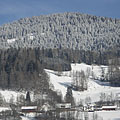(Оптимизован за уређаје са малим екранима)
Hungarian Natural History Museum, Giants of Patagonia - Dinosaurs of Argentina - Будимпешта, Мађарска
Када кликнете:
Кликните на сликама!
-
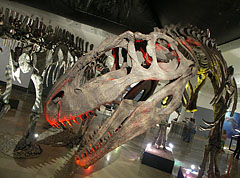
The enormous skull of the Giganotosaurus carolinii meat-eating theropod dinosaur
Датум фотографисања: 23. 06. 2007.2007
Цреатед би: Robert Németh
Модел фотоапарата: Konica Minolta Dimage A200
Будимпешта, Мађарска
-
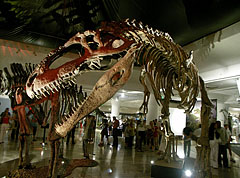
Came from South America, 14-meter-long, weighing 8 tons, its head is 2 meters long: it is the giant Giganotosaurus carolinii dinosaur
Датум фотографисања: 23. 06. 2007.2007
Цреатед би: Robert Németh
Модел фотоапарата: Konica Minolta Dimage A200
Будимпешта, Мађарска
-

The skull of the Carnotaurus sastrei meat-eater dinosaur
Датум фотографисања: 23. 06. 2007.2007
Цреатед би: Robert Németh
Модел фотоапарата: Konica Minolta Dimage A200
Будимпешта, Мађарска
-
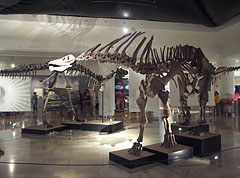
Amargasaurus cazaui, a member of the sauropod dinosaurs, although it is smaller than its relatives, it is even more interesting
Датум фотографисања: 23. 06. 2007.2007
Цреатед би: Robert Németh
Модел фотоапарата: Konica Minolta Dimage A200
Будимпешта, Мађарска
-
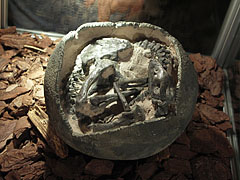
Fossilized dinosaur egg with an embryo (Mussaurus patagonicus)
Датум фотографисања: 23. 06. 2007.2007
Цреатед би: Robert Németh
Модел фотоапарата: Konica Minolta Dimage A200
Будимпешта, Мађарска
-

Map of the Neuquén province of Argentina with the discovered dinosaurs
Датум фотографисања: 23. 06. 2007.2007
Цреатед би: Robert Németh
Модел фотоапарата: Konica Minolta Dimage A200
Будимпешта, Мађарска
-

Skeleton of an early predatory dinosaur (Herrerasaurus ischigualastensis)
Датум фотографисања: 23. 06. 2007.2007
Цреатед би: Robert Németh
Модел фотоапарата: Konica Minolta Dimage A200
Будимпешта, Мађарска
-
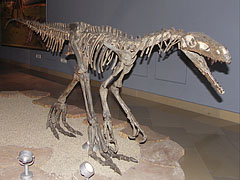
Herrerasaurus ischigualastensis, an early bipedal (walking on two legs) carnivorous dinosaur
Датум фотографисања: 23. 06. 2007.2007
Цреатед би: Robert Németh
Модел фотоапарата: Konica Minolta Dimage A200
Будимпешта, Мађарска
-
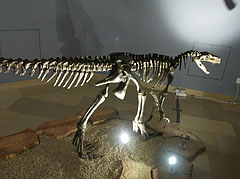
Skeleton of a Herrerasaurus ischigualastensis
Датум фотографисања: 23. 06. 2007.2007
Цреатед би: Robert Németh
Модел фотоапарата: Konica Minolta Dimage A200
Будимпешта, Мађарска
-
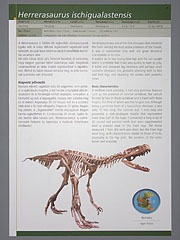
The information board of the Herrerasaurus ischigualastensis
Датум фотографисања: 23. 06. 2007.2007
Цреатед би: Robert Németh
Модел фотоапарата: Konica Minolta Dimage A200
Будимпешта, Мађарска
-
Skull of a tall theropod dinosaur (bipedal, walking on two legs), the Piatnitzkysaurus floresi
Датум фотографисања: 23. 06. 2007.2007
Цреатед би: Robert Németh
Модел фотоапарата: Konica Minolta Dimage A200
Будимпешта, Мађарска
Skull of a tall theropod dinosaur (bipedal, walking on two legs), the Piatnitzkysaurus floresi - Будимпешта, Мађарска -
Information board of the Piatnitzkysaurus floresi
Датум фотографисања: 23. 06. 2007.2007
Цреатед би: Robert Németh
Модел фотоапарата: Konica Minolta Dimage A200
Будимпешта, Мађарска
Information board of the Piatnitzkysaurus floresi - Будимпешта, Мађарска -
The Carnotaurus sastrei, a great carnivorous dinosaur
Датум фотографисања: 23. 06. 2007.2007
Цреатед би: Robert Németh
Модел фотоапарата: Konica Minolta Dimage A200
Будимпешта, Мађарска
The Carnotaurus sastrei, a great carnivorous dinosaur - Будимпешта, Мађарска -
The relatively small Amargasaurus cazaui herbivorous (plant eating) sauropod dinosaur
Датум фотографисања: 23. 06. 2007.2007
Цреатед би: Robert Németh
Модел фотоапарата: Konica Minolta Dimage A200
Будимпешта, Мађарска
The relatively small Amargasaurus cazaui herbivorous (plant eating) sauropod dinosaur - Будимпешта, Мађарска -
The strange vertebral spikes of the Amargasaurus cazaui dinosaur
Датум фотографисања: 23. 06. 2007.2007
Цреатед би: Robert Németh
Модел фотоапарата: Konica Minolta Dimage A200
Будимпешта, Мађарска
The strange vertebral spikes of the Amargasaurus cazaui dinosaur - Будимпешта, Мађарска -
Information board of the Amargasaurus cazaui
Датум фотографисања: 23. 06. 2007.2007
Цреатед би: Robert Németh
Модел фотоапарата: Konica Minolta Dimage A200
Будимпешта, Мађарска
Information board of the Amargasaurus cazaui - Будимпешта, Мађарска -
The front leg of the Megaraptor namunhuaiquit with giant claws
Датум фотографисања: 23. 06. 2007.2007
Цреатед би: Robert Németh
Модел фотоапарата: Konica Minolta Dimage A200
Будимпешта, Мађарска
The front leg of the Megaraptor namunhuaiquit with giant claws - Будимпешта, Мађарска -
The forelimb of the Megaraptor namunhuaiquit with fearsome giant claws
Датум фотографисања: 23. 06. 2007.2007
Цреатед би: Robert Németh
Модел фотоапарата: Konica Minolta Dimage A200
Будимпешта, Мађарска
The forelimb of the Megaraptor namunhuaiquit with fearsome giant claws - Будимпешта, Мађарска -
Skull of the Amargasaurus cazaui plant-eating (herbivorous) sauropod dinosaur
Датум фотографисања: 23. 06. 2007.2007
Цреатед би: Robert Németh
Модел фотоапарата: Konica Minolta Dimage A200
Будимпешта, Мађарска
Skull of the Amargasaurus cazaui plant-eating (herbivorous) sauropod dinosaur - Будимпешта, Мађарска -
Presentation of how the bones look like, when embedded in the rock
Датум фотографисања: 23. 06. 2007.2007
Цреатед би: Robert Németh
Модел фотоапарата: Konica Minolta Dimage A200
Будимпешта, Мађарска
Presentation of how the bones look like, when embedded in the rock - Будимпешта, Мађарска -
A Rebbachisaurus tessonei sauropod dinosaur between two predatory Giganotosaurus dinosaurs from the same age
Датум фотографисања: 23. 06. 2007.2007
Цреатед би: Robert Németh
Модел фотоапарата: Konica Minolta Dimage A200
Будимпешта, Мађарска
A Rebbachisaurus tessonei sauropod dinosaur between two predatory Giganotosaurus dinosaurs from the same age - Будимпешта, Мађарска -
Giganotosaurus carolinii, one of the world's largest carnivorous dinosaurs
At this time probably the Spinosaurus aegyptiacus was the largest carnivorous dinosaur ever (and the largest meat-eating land animal).
Датум фотографисања: 23. 06. 2007.2007
Цреатед би: Robert Németh
Модел фотоапарата: Konica Minolta Dimage A200
Будимпешта, Мађарска
Giganotosaurus carolinii, one of the world's largest carnivorous dinosaurs - Будимпешта, Мађарска -
The skull of the Giganotosaurus was alone 2 meters long, like a bathtub
Датум фотографисања: 23. 06. 2007.2007
Цреатед би: Robert Németh
Модел фотоапарата: Konica Minolta Dimage A200
Будимпешта, Мађарска
The skull of the Giganotosaurus was alone 2 meters long, like a bathtub - Будимпешта, Мађарска -
Skeleton reconstructions of small sized bipedal vegetarian dinosaurs (Gasparinisaura cincosaltensist)
Датум фотографисања: 23. 06. 2007.2007
Цреатед би: Robert Németh
Модел фотоапарата: Konica Minolta Dimage A200
Будимпешта, Мађарска
Skeleton reconstructions of small sized bipedal vegetarian dinosaurs (Gasparinisaura cincosaltensist) - Будимпешта, Мађарска -
Skull of the Abelisaurus comahuensis, a large predatory (meat-eating) dinosaur
Датум фотографисања: 23. 06. 2007.2007
Цреатед би: Robert Németh
Модел фотоапарата: Konica Minolta Dimage A200
Будимпешта, Мађарска
Skull of the Abelisaurus comahuensis, a large predatory (meat-eating) dinosaur - Будимпешта, Мађарска -
The skull of the Abelisaurus comahuensis
Датум фотографисања: 23. 06. 2007.2007
Цреатед би: Robert Németh
Модел фотоапарата: Konica Minolta Dimage A200
Будимпешта, Мађарска
The skull of the Abelisaurus comahuensis - Будимпешта, Мађарска -
Life-like head reconstruction of the Abelisaurus comahuensis
Датум фотографисања: 23. 06. 2007.2007
Цреатед би: Robert Németh
Модел фотоапарата: Konica Minolta Dimage A200
Будимпешта, Мађарска
Life-like head reconstruction of the Abelisaurus comahuensis - Будимпешта, Мађарска -
Skeleton of the 3-meter-long Tuarangisaurus cabazai long-necked plesiosaur (ancient marine reptile)
Датум фотографисања: 23. 06. 2007.2007
Цреатед би: Robert Németh
Модел фотоапарата: Konica Minolta Dimage A200
Будимпешта, Мађарска
Skeleton of the 3-meter-long Tuarangisaurus cabazai long-necked plesiosaur (ancient marine reptile) - Будимпешта, Мађарска -
Skull of the 5-meter-long mosasaur, the Taniwhasaurus antarcticus (or Lakumasaurus antarcticus) ancient marine reptile
Датум фотографисања: 23. 06. 2007.2007
Цреатед би: Robert Németh
Модел фотоапарата: Konica Minolta Dimage A200
Будимпешта, Мађарска
Skull of the 5-meter-long mosasaur, the Taniwhasaurus antarcticus (or Lakumasaurus antarcticus) ancient marine reptile - Будимпешта, Мађарска -
The skeleton of the Tuarangisaurus cabazai plesiosaur from the end of the age of the dinosaurs
Датум фотографисања: 23. 06. 2007.2007
Цреатед би: Robert Németh
Модел фотоапарата: Konica Minolta Dimage A200
Будимпешта, Мађарска
The skeleton of the Tuarangisaurus cabazai plesiosaur from the end of the age of the dinosaurs - Будимпешта, Мађарска -
The fight of the dinosaurs 100 million years ago: a Giganotosaurus attacks a herbivorous Rebbachisaurus
Датум фотографисања: 23. 06. 2007.2007
Цреатед би: Robert Németh
Модел фотоапарата: Konica Minolta Dimage A200
Будимпешта, Мађарска
The fight of the dinosaurs 100 million years ago: a Giganotosaurus attacks a herbivorous Rebbachisaurus - Будимпешта, Мађарска -
Dinosaur leg (Giganotosaurus carolinii)
Датум фотографисања: 23. 06. 2007.2007
Цреатед би: Robert Németh
Модел фотоапарата: Konica Minolta Dimage A200
Будимпешта, Мађарска
Dinosaur leg (Giganotosaurus carolinii) - Будимпешта, Мађарска -
Head reconstruction of an Abelisaurus, a great bipedal meat-eating dinosaur
Датум фотографисања: 23. 06. 2007.2007
Цреатед би: Robert Németh
Модел фотоапарата: Konica Minolta Dimage A200
Будимпешта, Мађарска
Head reconstruction of an Abelisaurus, a great bipedal meat-eating dinosaur - Будимпешта, Мађарска -
Special surprise: an (of course living) elephant hawk-moth (Deilephila elpenor) on the dinosaur bones
Датум фотографисања: 23. 06. 2007.2007
Цреатед би: Robert Németh
Модел фотоапарата: Konica Minolta Dimage A200
Будимпешта, Мађарска
Special surprise: an (of course living) elephant hawk-moth (Deilephila elpenor) on the dinosaur bones - Будимпешта, Мађарска -
An elephant hawk-moth (Deilephila elpenor) on dinosaur bones
Датум фотографисања: 23. 06. 2007.2007
Цреатед би: Robert Németh
Модел фотоапарата: Konica Minolta Dimage A200
Будимпешта, Мађарска
An elephant hawk-moth (Deilephila elpenor) on dinosaur bones - Будимпешта, Мађарска -
Board of the Giganotosaurus
Датум фотографисања: 23. 06. 2007.2007
Цреатед би: Robert Németh
Модел фотоапарата: Konica Minolta Dimage A200
Будимпешта, Мађарска
Board of the Giganotosaurus - Будимпешта, Мађарска -
Tangible "fossils" for the children in the exhibition
Датум фотографисања: 23. 06. 2007.2007
Цреатед би: Robert Németh
Модел фотоапарата: Konica Minolta Dimage A200
Будимпешта, Мађарска
Tangible "fossils" for the children in the exhibition - Будимпешта, Мађарска -
Head (skull) of the Carnotaurus sastrei carnivorous dinosaur
Датум фотографисања: 23. 06. 2007.2007
Цреатед би: Robert Németh
Модел фотоапарата: Konica Minolta Dimage A200
Будимпешта, Мађарска
Head (skull) of the Carnotaurus sastrei carnivorous dinosaur - Будимпешта, Мађарска -
The wierd, fearsome looking Carnotaurus sastrei carnivorous dinosaur (ancient reptile)
Датум фотографисања: 23. 06. 2007.2007
Цреатед би: Robert Németh
Модел фотоапарата: Konica Minolta Dimage A200
Будимпешта, Мађарска
The wierd, fearsome looking Carnotaurus sastrei carnivorous dinosaur (ancient reptile) - Будимпешта, Мађарска -
Looks like the Evil himself! (but fortunately just the skull of a Carnotaurus sastrei dinosaur)
Датум фотографисања: 23. 06. 2007.2007
Цреатед би: Robert Németh
Модел фотоапарата: Konica Minolta Dimage A200
Будимпешта, Мађарска
Looks like the Evil himself! (but fortunately just the skull of a Carnotaurus sastrei dinosaur) - Будимпешта, Мађарска -
The 4-meter-long armored Hungarosaurus tormai was the first dinosaur, that was discovered in the area of the present-day Hungary
Датум фотографисања: 23. 06. 2007.2007
Цреатед би: Robert Németh
Модел фотоапарата: Konica Minolta Dimage A200
Будимпешта, Мађарска
The 4-meter-long armored Hungarosaurus tormai was the first dinosaur, that was discovered in the area of the present-day Hungary - Будимпешта, Мађарска -
Information board of the Hungarosaurus tormai armored dinosaur
Датум фотографисања: 23. 06. 2007.2007
Цреатед би: Robert Németh
Модел фотоапарата: Konica Minolta Dimage A200
Будимпешта, Мађарска
Information board of the Hungarosaurus tormai armored dinosaur - Будимпешта, Мађарска -
The table of a paleontologist should look something like this, with all kinds of fossils
Датум фотографисања: 23. 06. 2007.2007
Цреатед би: Robert Németh
Модел фотоапарата: Konica Minolta Dimage A200
Будимпешта, Мађарска
The table of a paleontologist should look something like this, with all kinds of fossils - Будимпешта, Мађарска
Кликните на сликама!
Карактеристике, особине
Положај:
ГПС координате: Ширина 47°28'56", Дужина 19°5'8" (N47 28.93 - E19 5.13)
Информације, кратке приче, занимљивих чињеница
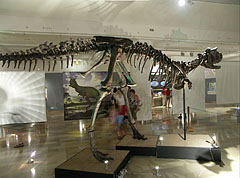 The Carnotaurus sastrei, a great carnivorous dinosaur
The Carnotaurus sastrei, a great carnivorous dinosaur
The bipedal (walking on the two rear legs) theropod Carnotaurus is special but not only because of its appearance. This was a large carnivorous dinosaur with extremely small forelimbs, as well as unique horn-like structures over its eyes. Interestingly almost a complete skeleton was excavated, and to top it all in a natural position (it was laid in a so-called hematite mineral inclusion). The most unique discovery was that beside the bones also skin imprints were remained from this 8-meter-long animal that was weighing 1200 kilograms and lived about 80 million years ago! This kind of paleontological find is very-very rare, this valuable fossil type can answer a lot of things, that the bones alone cannot. For example it can be recognized that the skin of the Carnotaurus was covered by evenly spaced bumps and it looked similar to the skin of the present pachyderms (thick-skinned mammals).
 Amargasaurus cazaui, a member of the sauropod dinosaurs, although it is smaller than its relatives, it is even more interesting
Amargasaurus cazaui, a member of the sauropod dinosaurs, although it is smaller than its relatives, it is even more interesting
The herbivorous (plant eating) Amargasaurus dinosaur was explored in Argentina, it was named after the Amarga Stream ("Arroyo La Amarga") which is close to the exploration site. All of our knowledge is coming from this as of today only one explored fossil of this species, however this is in quite good conditions. The exhibited skeleton in the temporary exhibition of the Hungarian Natural History Museum ("Magyar Természettudományi Múzeum") is of course just a replica.
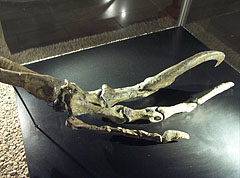 The front leg of the Megaraptor namunhuaiquit with giant claws
The front leg of the Megaraptor namunhuaiquit with giant claws
The science is not set in stone, even it sounds stange when talking about prehistoric fossils. Here is a great example for this case. The paleontologists could be very surprised when not so long ago it was revealed that the hind leg of a big bipedal predatory dinosaur called Megaraptor namunhuaiquit is actually its foreleg. This dinosaur was known based on only a single fossil for long time, which was a giant, at least 30-centimeter-long razor-sharp sickle-shaped claw. As its scientific name shows this animal was first classified as a member of the raptor family, which are usually small or medium sized fast theropoda dinosaurs, walking on two legs, and each hindfoot has a big sickle-shaped claw.
However, the tables were turned when a complete forelimb of a Megaraptor was found, with the already known giant claw on its first finger. This has made it clear that it couldn't be a raptor but something else. Based on further new discoveries the relationship of the Megaraptor is slowly taking shape, for example the allosauroid Australovenator from the Cretaceous Period could be probably one of its relative.
It is sure that it was big, but the exact appearance can be only assumed and still questionable. After 2007 the "Giants of Patagonia - Dinosaurs of Argentina" exhibition came back to the Hungarian Natural History Museum ("Magyar Természettudományi Múzeum") in 2013 again, and then the whole imaginary complete skeleton of the Megaraptor already could be seen. It was created based on the explored foreleg and the anatomy of the animal's relatives.
So what's the lesson? The science is flexible, newer knowledges, proven findings or rational arguments can even completely upset the previous theories. Among other things this enlightened approach distinguishes it from for example the religions and other dogmas, where the smallest spark of the divergent thinking could lead event to a war. Most of the times the religions say they know the truth, but the science modestly satisfied the fact that it just tries to find it.
In this certain case in the scientific knowledge the hind leg of an animal "became" foreleg in few years, but of course this change took place in a peaceful way even in the scientific community, because why wouldn't they believe their own eyes.
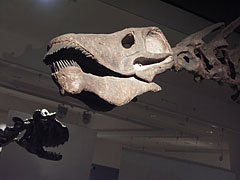 Skull of the Amargasaurus cazaui plant-eating (herbivorous) sauropod dinosaur
Skull of the Amargasaurus cazaui plant-eating (herbivorous) sauropod dinosaur
The plant eating sauropod dinosaur group (Sauropoda) was consisted of mostly giant animals, the Amargasaurus which was lived about 130 million years ago was relatively small compared to them. Its strange teeth could be even frightful, but these are just very practical: these were evolved to collect the plant food. The sauropods used their teeth like a comb, they "ripped off" all the leaves from a branch with one movement then swallowed them without chewing. The food procession exclusively depended on their very long and special digestive tract.
A larger animal has longer digestive system, so the body can process the food for longer time, and due to the same reason a large animal can eat even lower quality food. The primary target was the fast eating, therefore the more rapid growth. It is no wonder, because the big size was the major weapon of this prehistoric reptile group agains the predators. Probably that's why the bone spikes on the neck of the Amargasaurus were evolved, to somewhat compensate the relatively smaller size of this sauropod dinosaur.
Будимпешта - Више фото галерије:
Можете такође бити заинтересовани (Повезане странице):
Дестинације у туристичком водичу:
Будимпешта (8 468 фотографије + 21 панорамске слике)
Buda Hills (Budai-hegység) (8 632 фотографије + 21 панорамске слике)
Pest megye (county) (15 122 фотографије + 50 панорамске слике)
Будимпешта и њена околина (Централна Мађарска) (15 989 фотографије + 52 панорамске слике)
Мађарска (27 287 фотографије + 163 панорамске слике)
и додатно:
(у овде: Buda Hills)
Budakeszi (88 фотографије)
Pilisszentiván (76 фотографије)
Свака панорамска слика овде:
Будимпешта (21 фотографије)
Pest megye (county) (50 фотографије)
Будимпешта и њена околина (Централна Мађарска) (52 фотографије)
Мађарска (163 фотографије)
Европа (165 фотографије)
Сваки нормални фото овде:
Будимпешта (8 468 фотографије / 122 галерије)
Buda Hills (Budai-hegység) (8 632 фотографије / 124 галерије)
Pest megye (county) (15 122 фотографије / 221 галерије)
Будимпешта и њена околина (Централна Мађарска) (15 989 фотографије / 234 галерије)
Мађарска (27 287 фотографије / 462 галерије)
Европа (30 494 фотографије / 523 галерије)
https://www.panadea.com/sr/guidebook/budimpeshta/photos/gal-075

Додај у Фаворите Додај у Омиљене
Подели са својим пријатељима!
итд
О нама - Одрицање одговорности -
Сва права задржана
- ©2010-2022
Neuronit Creative Studio - Mogyoród / Будимпешта / Мађарска




